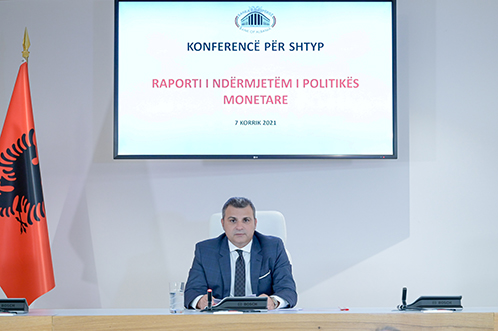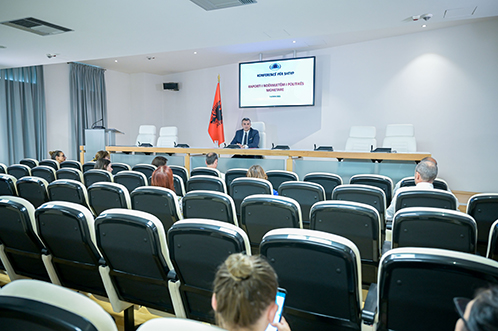BANK OF ALBANIA
PRESS RELEASE
Governor Sejko: Statement to the Press Conference on Monetary Policy Decision, 7 July 2021
Publication date: 07.07.2021
Dear Ladies and Gentlemen,
Today, on 7 July 2021, the Supervisory Council of the Bank of Albania reviewed and approved the Intermediate Monetary Policy Report.
The new analysed information suggests that the Albanian economy has shown a clear recovery trend in the first half of 2021. Also, inflation has been upward in April and May, by correcting the fall in the first quarter.

The updated projections affirm the scenarios we have introduced continuously during 2021. The Albanian economy is expected to record a swift and sustainable growth in the current year and in the next two years. This growth, in turn, will enable an expansion of employment and rise of wages, by establishing the premises for inflation to return to its target during 2022.
The Supervisory Council deems that factors underpinning the rebound of the Albanian economy have been expanding and strengthening. In addition, downside risks, despite still present, have been reducing. Nevertheless, the Supervisory Council points out that inflation continues to undershoot the target, employment continues to remain below the potential level, and the stability of economic growth continues to require maintaining the simulating monetary conditions.

Against this backdrop, the Supervisory Council assesses that the current monetary policy stance remains adequate.
Following, I will introduce in more details the reasons backing the decision-taking and the conclusions on the discussions of the Supervisory Council.
***
Inflation has pursued an upward trend in April and May. The average rate of inflation settled at 1.9% in April and May, notably above the average of the first quarter Inflation rose mainly due to the increase in food and oil prices. Meanwhile, the prices of other basket items did not change significantly. This dynamic affirms our previous estimations that the fall of inflation in the first quarter would be temporary. At the same time, it suggests that current speed of its increase is unstable.
Factors conditioning the stable return of inflation to target are being improved, but it is expected to converge to target in the medium term. The growth of aggregate demand still has not enabled the stable increase of employment and wages. In addition, the rapid upsurge of consumption prices in partner countries appears to be a transitional phenomenon, for the moment. Last, economic agents’ expectations for inflation continue to remain below the target.
The Bank of Albania assesses that all these three factors will be improving in the medium-term horizon.
In line with our exceptions, economic activity in Albania has been recovering in the first two quarters of 2021. According to INSTAT data, the Albanian economy grew by 5.5% in 2021 Q1, while analysis of indirect data suggests even faster growth rates in the second quarter.
The recovery of economic activity expanded on a broad base. In terms of aggregate demand, it reflected the expansion of consumption and private investments, increase of budget expenditures and the expansion of goods and services. In sectoral terms, it reflected the simultaneous expansion in production sector and services sector.
The improvement of economic activity is still not completely reflected in the labour market. According to INSTAT data, employment recorded an annual fall of 2.6% in 2021 Q1, while unemployment rate stood at 11.9%. These indicators suggest the Albania economy is still far from the complete normalisation of its activity and simulating policies should continue to sustain this process.
The supportive factors of economic growth have been consolidating. Reduction of containment measures due to the vaccination process, the improvement in business and consumer’s confidence, expansion of foreign demand, and both fiscal and monetary stimulus, have established the necessary premises for a gradual normalisation of economic activity.
Fiscal policy has continued to maintain a simulating nature during the first half of year. Fiscal stimulus was in the form of expanded current and capital expenditure, by 10% and 29%, respectively, till May, while budget revenues grew by around 19%. The observation of budget projections implies that fiscal stimulus will remain present during 2021, while it is expected to tighten in the next years. The Bank of Albania assesses that maintaining this fiscal policy stance serves both to supporting the economic rebound in the short run and to strengthening fiscal stability in the long term.
In parallel with fiscal stimulus, the accommodative monetary policy has enabled to create favourable financing conditions. Financial markets operate smoothly and are characterised by ample liquidity and contained risk premia. Their good situation has allowed the effective pass through of fiscal stimulus, which in turn has maintained the interest rates on loans to private sector at low levels. Also, the exchange rate appears stable, by reflecting the supply and demand balance for foreign currency.
The improvement of loan demand and the favourable supply-side conditions have driven to a relatively fast growth of lending. Credit portfolio to private sector recorded an annual increase of 7.8% in May, from the average growth rate of 6.8% in 2020. Beyond the overall growth of portfolio, lending dynamics provide other positive signals. First, the increase of credit portfolio has broadly supported the financing of enterprises’ investments and for mortgage loans, by signalling the upsurge of investments in the private sector and an improving situation of its liquidity. Second, loans in the domestic currency continues to maintain higher increasing rates, by being reflected in the progressive growth of the share of loans in lek to total credit. This encouraging development establishes the premises for a better transmission of the monetary stimulus and a higher resilience of the banking system against the financial stability risks. Third, non-performing loans ration fell to 7.8% in May, by suggesting a good quality of this portfolio.
Judging on the factual trends of the economic and monetary developments, and their determinant factors, the Supervisory Council deems that the Albanian economy will record fast and stable economic growth rates in the medium-term horizon. The improvement of external environment, the reduction of uncertainty, the simulating fiscal-monetary policy mix and the strengthening of private sector’s balance sheets will underpin the economic growth. These factors are expected to boost the increase of: consumption; exports; and investments; as well as gradually increase incomes in all sectors of economy. The expansion of the demand will support the increase of employment, in turn, further rise in wages, and a gradual convergence of inflation to target within 2022.
In any case, the projections are based on assumption of avoiding the serious restrictions on the economic activity, due to further shocks from the pandemic. Nevertheless, the course of the coronavirus (COVID-19) pandemic and its impact on economy continue to remain source of uncertainty in economic forecasts.
The Supervisory Council assesses that downside risks have somewhat faded out further in this round of analyses, and the overall balance of risks appears more neutral. In particular, downside risks arise from: deterioration in the epidemiological situation and its negative impact on the economy; and a slower rebound of both consumption and investments, due to a more prudential behaviour of Albanian households and enterprises. Conversely, upside risks arise from a more expansionary domestic fiscal policy than current forecasts, and from a more rapid increase of inflation in partner countries.
***
In consistence with these projections, the Supervisory Council assesses that the current monetary policy stance remains adequate.
In this view, the Supervisory Council decided to:
- Keep the policy rate unchanged, at 0.5%;
- Keep the overnight deposit and overnight lending rates, unchanged at 0.1% and 0.9%, respectively.
In addition, the Supervisory Council judges that monetary policy stance will continue to remain accommodative throughout the medium-term horizon, for the steady rebound of economic activity and for the return of inflation to target.

 Twitter
Twitter
 Youtube
Youtube
 Facebook
Facebook
 Flickr
Flickr
 RSS
RSS
 Subscribe
Subscribe
 Feedback
Feedback